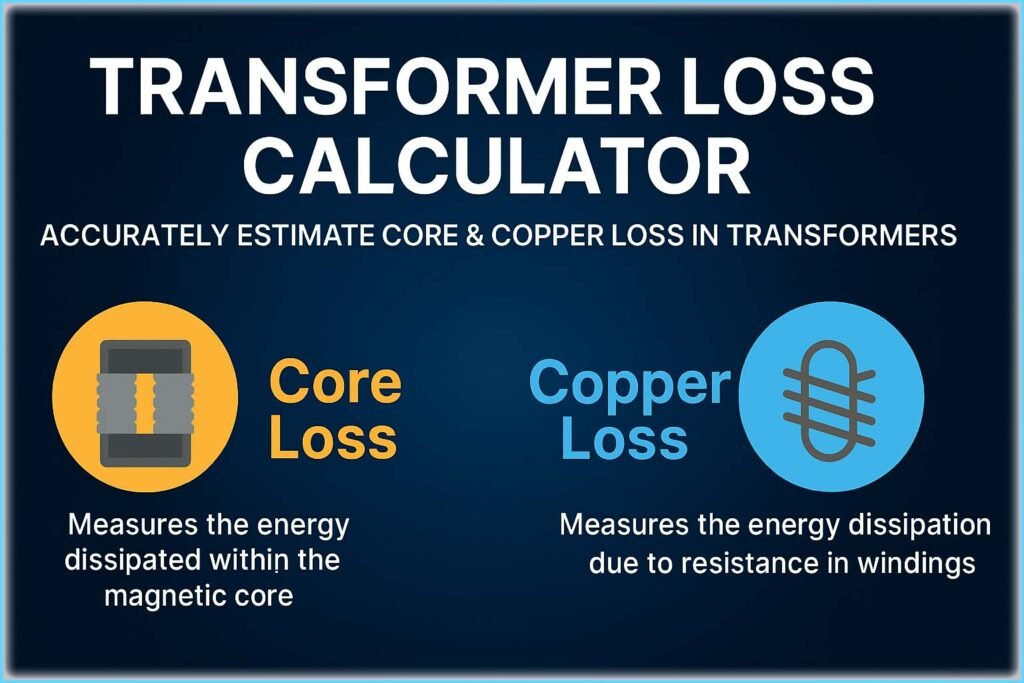Transformer Loss Calculator – Accurately Estimate Core & Copper Loss in Transformers
Transformers are essential components in power systems, ensuring efficient voltage conversion and energy transmission. However, no transformer is perfectly efficient — every unit experiences some energy loss during operation. These losses affect both performance and cost-efficiency. That’s where a Transformer Loss Calculator becomes an invaluable tool. It helps engineers, technicians, and energy auditors quickly estimate total transformer losses, efficiency, and energy costs. Understanding and managing these losses is critical for optimizing power systems, especially in industries and large-scale electrical networks.

Table of Contents
When you use a Transformer Loss Calculator, you can determine how much energy is being wasted as heat or core magnetization and how that impacts your power bills over time. This information helps you make better choices about transformer selection, loading levels, and replacement decisions. It’s also a practical way to compare performance between different transformer ratings and models.
Before diving into how the calculator works, let’s explore the key types of transformer losses and why they matter in electrical engineering.
Key Takeaways
- The Transformer Loss Calculator helps estimate both core and copper losses in a transformer.
- It allows accurate calculation of total energy losses and efficiency under different loading conditions.
- Using it regularly can optimize energy savings and reduce operational costs for power systems.
Understanding Transformer Losses
Every transformer, regardless of size, has two major categories of losses — no-load losses and load losses. These losses are unavoidable but can be calculated accurately to determine the transformer’s efficiency.
Transformer Loss Calculator
Estimate daily energy losses and cost impact based on transformer load, core and copper losses, and operating hours.
Use our online tool EV Charger Energy Usage Cost Calculator
1. No-Load (Core) Losses
No-load losses occur when the transformer is energized but not supplying any load. They are caused mainly by the magnetization of the core. The two main components are:
- Hysteresis loss: Due to continuous magnetization and demagnetization of the core material.
- Eddy current loss: Caused by circulating currents within the iron core.
These losses are almost constant, regardless of load, and depend mainly on voltage and frequency.
2. Load (Copper) Losses
Load losses occur when the transformer delivers current to the load. These losses vary with the square of the load current. The main component is:
- I²R loss: Generated by the resistance of the winding conductors when current flows through them.
Copper losses increase rapidly with load, making it important to maintain optimal loading for efficiency.
What is a Transformer Loss Calculator?
A Transformer Loss Calculator is a simple yet powerful tool that computes the total energy losses occurring in a transformer based on a few basic inputs. It helps determine:
- No-load loss (core loss)
- Load loss (copper loss)
- Total loss in watts or kilowatts
- Transformer efficiency at given load conditions
This tool is especially helpful for engineers who need quick, accurate estimations for performance analysis, energy audits, or transformer comparisons.
The Transformer Loss Calculator uses standard transformer formulas derived from IEC and IEEE standards. By entering your transformer’s rating, load percentage, voltage, and losses, you can immediately view total energy loss and efficiency results.
Use our online tool EV Charger Load Calculation Tool – Accurate Power Estimation for Home and Commercial EV Chargers
How Transformer Loss Calculator Works
To calculate transformer losses, the following parameters are typically required:
| Parameter | Description |
|---|---|
| Rated Power (kVA) | The transformer’s nameplate rating |
| No-load Loss (W) | Iron or core loss measured at rated voltage |
| Load Loss (W) | Copper loss measured at rated current |
| Load Percentage (%) | Actual load as a percentage of full load |
| Operating Hours | Time duration in hours for which transformer runs |
| Energy Cost (per kWh) | Cost per unit of energy used for loss cost estimation |
The Transformer Loss Calculator combines these inputs to give instant results for total energy loss and efficiency.
Formula Used in Transformer Loss Calculator
The calculator is based on the following standard equations:
1. No-load loss (constant):

2. Load loss (variable):

3. Total Loss:

4. Efficiency (%):

Use our online tool Inverter Size Calculator VA Rating by Load – Find the Perfect Inverter for Your Home or Office
5. Energy Lost per Year (kWh):

6. Cost of Energy Loss:

These formulas give a comprehensive view of how much power is lost and its cost implications.
Example: Using the Transformer Loss Calculator
Let’s take an example to understand how to use the Transformer Loss Calculator effectively.
| Parameter | Value |
|---|---|
| Rated Power | 1000 kVA |
| No-load Loss | 1500 W |
| Load Loss | 9000 W |
| Load Percentage | 75% |
| Operating Hours | 8760 (1 year) |
| Energy Cost | $0.10 per kWh |
Step 1: Calculate load loss

Step 2: Total loss

Step 3: Energy loss per year

Step 4: Cost of energy loss

Use our online tool Solar Panel Size Calculator by Load – Find the Right System for Your Power Needs
This means the transformer loses around $5745.75 per year due to inefficiencies. With the Transformer Loss Calculator, such insights can be generated instantly.
Why Use a Transformer Loss Calculator?
Using a Transformer Loss Calculator provides several real-world benefits for both engineers and facility owners.
1. Accurate Efficiency Estimation
You can instantly compute transformer efficiency under various load conditions to determine its optimal performance point.
2. Energy Cost Management
The calculator helps quantify the annual financial impact of energy losses, guiding energy-saving investments.
3. Better Transformer Selection
It allows easy comparison between two or more transformers to choose the most efficient one for long-term cost savings.
4. Preventive Maintenance
Frequent use helps identify performance degradation or unexpected rise in losses, indicating maintenance needs.
5. Supports Energy Audits and Certifications
Energy auditors can rely on it to document accurate transformer loss data in compliance with IEC and IEEE standards.
Typical Transformer Loss Data
For better understanding, here’s an approximate range of transformer losses for different ratings:
| Transformer Rating (kVA) | No-Load Loss (W) | Load Loss (W) |
|---|---|---|
| 100 kVA | 250 | 1800 |
| 250 kVA | 500 | 3000 |
| 500 kVA | 900 | 5000 |
| 1000 kVA | 1500 | 9000 |
| 2000 kVA | 2600 | 16000 |
These values vary depending on core material, design, and manufacturer. Using the Transformer Loss Calculator, you can input your specific values to get precise results.
Factors Affecting Transformer Losses
Several operational and design factors influence transformer losses. The Transformer Loss Calculator can help you analyze these variations easily:
- Load variation: Higher load increases copper losses exponentially.
- Core quality: Poor quality or aged cores have higher hysteresis and eddy losses.
- Temperature: Higher ambient temperature increases winding resistance.
- Frequency: Minor frequency changes affect eddy current losses.
- Voltage variation: Affects core magnetization and consequently the no-load loss.
Monitoring these parameters through your calculator inputs helps maintain optimal efficiency.
Use our online tool Solar Charge Controller Sizing Calculator: Important Tool
Enhancing Transformer Efficiency
Reducing transformer losses can significantly lower operational costs. Here are a few simple practices to consider:
- Use transformers with amorphous steel cores for lower core loss.
- Maintain loading between 60% to 80% for peak efficiency.
- Ensure proper cooling and ventilation.
- Regularly inspect winding resistance and insulation quality.
- Replace older transformers with energy-efficient models.
Each small improvement can yield measurable energy savings, especially for transformers running 24/7.
Conclusion
The Transformer Loss Calculator is an essential tool for modern energy management. It gives you clear insights into no-load and load losses, overall efficiency, and the cost impact of wasted energy. Whether you’re an engineer, a facility manager, or an energy consultant, this calculator empowers you to make data-driven decisions about transformer performance and replacement.
By regularly analyzing your system with a Transformer Loss Calculator, you can reduce energy waste, extend transformer life, and improve power system reliability. In industries where transformers operate continuously, even a 1% improvement in efficiency translates to huge savings over time.
Follow Us on Social:
Subscribe our Newsletter on Electrical Insights to get the latest updates in Electrical Engineering.
#TransformerLossCalculator, #TransformerEfficiency, #ElectricalEngineering, #PowerTransformer, #CoreLoss, #CopperLoss, #TransformerDesign, #EnergyLoss, #TransformerTesting, #ElectricalCalculations, #TransformerLoadLoss, #DistributionTransformer, #TransformerPerformance, #EnergyEfficiency, #PowerSystemAnalysis
Transformer Loss Calculator – Accurately Estimate Core & Copper Loss in Transformers : Electrical Engineering Hub

Use our Transformer Loss Calculator to quickly estimate core loss, copper loss, and total transformer efficiency. Ideal for engineers and technicians to analyze power loss and performance in transformers with precision
Price Currency: USD
Operating System: All
Application Category: Engineering Application
